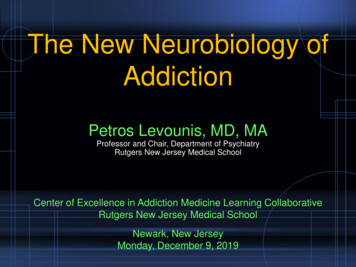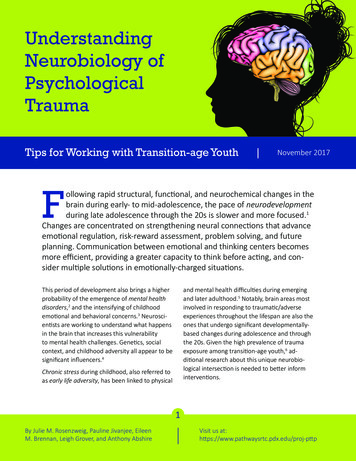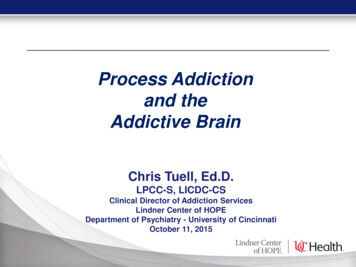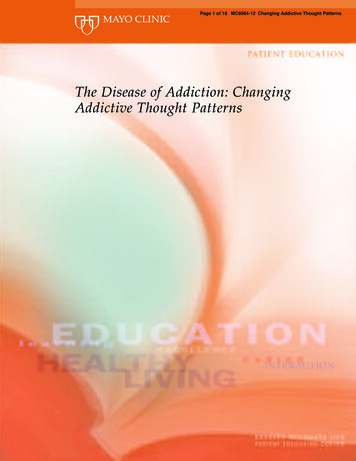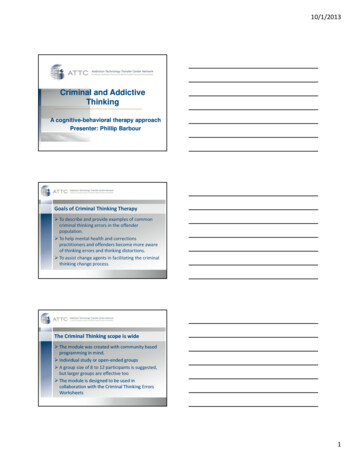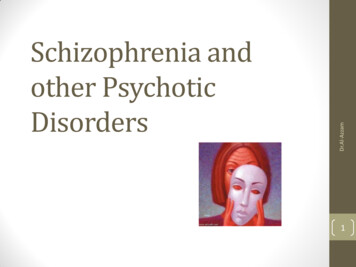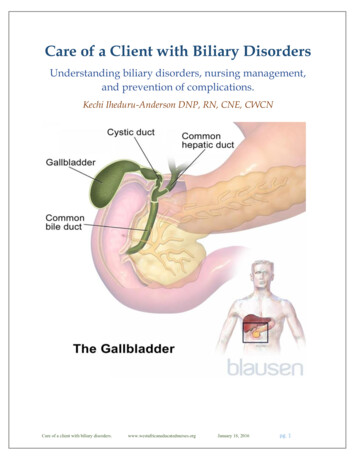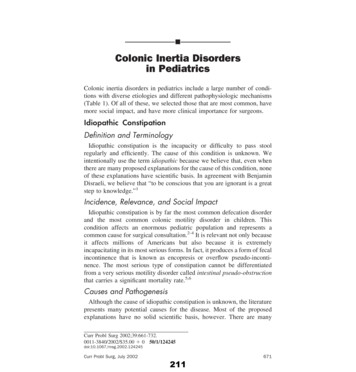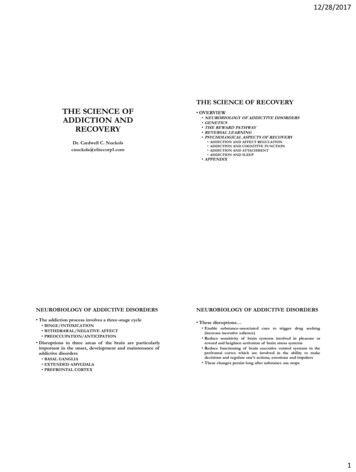
Transcription
12/28/2017THE SCIENCE OF RECOVERYTHE SCIENCE OFADDICTION ANDRECOVERYDr. Cardwell C. Nuckolscnuckols@elitecorp1.com OVERVIEW NEUROBIOLOGY OF ADDICTIVE DISORDERSGENETICSTHE REWARD PATHWAYREVERSAL LEARNINGPSYCHOLOGICAL ASPECTS OF RECOVERY ADDICTION AND AFFECT REGULATIONADDICTION AND COGNITIVE FUNCTIONADDICTION AND ATTACHMENTADDICTION AND SLEEP APPENDIXNEUROBIOLOGY OF ADDICTIVE DISORDERS The addiction process involves a three-stage cycle BINGE/INTOXICATION WITHDRAWAL/NEGATIVE AFFECT PREOCCUPATION/ANTICIPATION Disruptions in three areas of the brain are particularlyimportant in the onset, development and maintenance ofaddictive disorders BASAL GANGLIA EXTENDED AMYGDALA PREFRONTAL CORTEXNEUROBIOLOGY OF ADDICTIVE DISORDERS These disruptions Enable substance-associated cues to trigger drug seeking(increase incentive salience) Reduce sensitivity of brain systems involved in pleasure orreward and heighten activation of brain stress systems Reduce functioning of brain executive control systems in theprefrontal cortex which are involved in the ability to makedecisions and regulate one’s actions, emotions and impulses These changes persist long after substance use stops1
12/28/2017NEUROBIOLOGY OF ADDICTIVE DISORDERS:THREE AREAS OF THE BRAINNEUROBIOLOGY OF ADDICTIVE DISORDERS BASAL GANGLIA Controls the rewarding effects of substance abuse andresponsible for habit formation Two important sub-regions in substance use disorders NUCLEUS ACCUMBENS Motivation and the experience of reward DORSAL STRIATUM Habit formation and other routine behaviorsNEUROBIOLOGY OF ADDICTIVE DISORDERSNEUROBIOLOGY OF ADDICTIVE DISORDERS EXTENDED AMYGDALA PREFRONTAL CORTEX Involved in stress including behavioral responses such as “fightor flight” Feelings of unease, anxiety and irritability that typicallyaccompany withdrawal Interacts with the hypothalamus with controls glandular activityand in the right hemisphere has top down control of theautonomic nervous system Hypothalamic-pituitary-adrenal axis controls response to stress Involved in executive function (i.e. the ability to organizethoughts and activities, prioritize tasks, manage time and makedecisions) including exerting control over substance taking These three brain areas and their associated networks arecritical to survival and are “hijacked” by addictivesubstances2
12/28/2017NEUROBIOLOGY OF ADDICTIVE DISORDERS THE ADDICTION CYCLE A repeating cycle with three stages BINGE/INTOXICATION The stage in which an individual consumes a mind-alteringsubstance and experiences a rewarding or pleasurable effect WITHDRAWAL/NEGATIVE AFFECT The stage at which an individual experiences a negative emotionalstate in the absence of the mind-altering substance PREOCCUPATION/ANTICIPATION The stage at which one seeks the mind-altering substance againafter a period of abstinence The stages are linked to and feed off of each otherNEUROBIOLOGY OF ADDICTIVE DISORDERS THE ADDICTION CYCLE A person may go through the three-stage cycle over the course ofweeks or months or progress through it several times in a day Tends to intensify over time, leading to greater physical andpsychological harm FOUR BEHAVIORS CENTRAL TO THE ADDICTION CYCLE IMPULSIVITY POSITIVE REINFORCEMENT (diminish over time leading to tolerance) NEGATIVE REINFORCEMENT (removal of a stimulus such as negativeemotions increases the probability of repeated use) COMPULSIVITY (reduces tension, stress or anxiety)NEUROBIOLOGY OF ADDICTIVE DISORDERS:NEUROBIOLOGY OF ADDICTIVE DISORDERSTHREE STAGE CYCLE THE ADDICTION CYCLE Positive and negative reinforcement need not be driven solelyby the pharmacological effects of the drug (peer pressure, relieffrom loneliness and isolation are negatively reinforcing) As use becomes ingrained behavior, impulsivity shifts tocompulsivity and the primary drivers shift from positivereinforcement (feeling pleasure) to negative reinforcement(feeling relief)3
12/28/2017NEUROBIOLOGY OF ADDICTIVE DISORDERS BINGE/INTOXICATION STAGE: BASAL GANGLIA Heavily involves the basal ganglia and two sub-regionscalled the Nucleus Accumbens(NAc) and dorsalstriatum The rewarding effects involve activation of the nucleusaccumbens and includes activation of the dopamineand opioid signaling system Over time the brains reward system is “hijacked”NEUROBIOLOGY OF ADDICTIVE DISORDERS BINGE/INTOXICATION STAGE: BASAL GANGLIA Despite diverse initial actions, addictive substances produce somecommon effects on the Ventral Tegmental Area(VTA) and NAc Stimulants directly increase dopamine transmission in the NAc.Opioids, alcohol and inhalants do the same indirectly Alcohol also activates the release of opioid peptides Opioids directly activate opioid peptide receptors Nicotine activates dopamine neurons in the VTA Cannabinoids may act in the VTA to activate dopamine neurons andalso act on NAc neurons, as well as, the endogenous cannabinoidsystemNEUROBIOLOGY OF ADDICTIVE DISORDERS BINGE/INTOXICATION STAGE: BASAL GANGLIA Over time stimuli (People, Places and Things) can activate thedopamine system and/or trigger powerful urges to take thesubstance The “wanting” urges are called incentive salience Researchers give an animal a stimulant drug along with a previouslyneutral stimulus (light, sound, etc.) The neutral stimulus can now cause the animal to engage in drugseeking behavior In recording the electrical activity of DA-transmitting neurons that hadbeen exposed multiple times to a neutral stimulus followed by the drug At first, the neurons responded only when exposed to the drug Over time the neurons stopped firing when exposed to drug andonly responded to the neutral stimulus (i.e. brain starts to releaseDA due to People, Places and Things)4
12/28/2017NEUROBIOLOGY OF ADDICTIVE DISORDERS BINGE/INTOXICATION STAGE: BASAL GANGLIA A second sub-region of the basal ganglia, the dorsal striatuminvolved in habit formation The release of dopamine (along with activation of the brainopioid systems) and the release of glutamate trigger changes inthe dorsal striatum This strengthens drug-seeking contributing to compulsive useand intense cravingNEUROBIOLOGY OF ADDICTIVE DISORDERS BINGE/INTOXICATION STAGE: BASAL GANGLIA SUMMARY: The “reward circuitry” of the basal ganglia (i.e., the nucleus accumbens),along with dopamine and naturally occurring opioids, play a key role in therewarding effects of alcohol and other substances and the ability of stimuli,or cues, associated with that substance use to trigger craving, substanceseeking, and use. As alcohol or substance use progresses, repeated activation of the “habitcircuitry” of the basal ganglia (i.e., the dorsal striatum) contributes to thecompulsive substance seeking and taking that are associated with addiction. The involvement of these reward and habit neurocircuits helps explain theintense desire for the substance (craving) and the compulsive substanceseeking that occurs when actively or previously addicted individuals areexposed to alcohol and/or drug cues in their surroundings.NEUROBIOLOGY OF ADDICTIVE DISORDERS:NEUROTRANSMITTER SYSTEMS IMPLICATED INNEUROADAPTIONS DURING BINGE/INTOXICATIONSTAGENEUROBIOLOGY OF ADDICTIVE DISORDERS WITHDRAWAL/NEGATIVE AFFECT STAGE:EXTENDED AMYGDALA When stop taking the drug negative emotions and symptoms ofphysical illness appear This generally leads to binge/intoxication The negative feelings are thought to come from two sourcesdiminished activation of the reward circuitry of the basalganglia and activation of the brains stress systems in theextended amygdala5
12/28/2017NEUROBIOLOGY OF ADDICTIVE DISORDERS:THE WITHDRAWAL/NEGATIVE AFFECTSTAGE AND THE EXTENDED AMYGDALANEUROBIOLOGY OF ADDICTIVE DISORDERS WITHDRAWAL/NEGATIVE AFFECT STAGE:EXTENDED AMYGDALA Imaging studies of addicts show a long-lasting decrease onDAD2 receptors (see next slide) Creates a reduction in the sensitivity of the brain’s rewardsystem both to addictive substances and to natural reinforcers This can lead to a compulsive escalation of use in an attempt toregain the pleasurable feelings the reward system once providedNEUROBIOLOGY OF ADDICTIVE DISORDERS:COMPARISON OF CONTROL TO COCAINE ADDICTNEUROBIOLOGY OF ADDICTIVE DISORDERS WITHDRAWAL/NEGATIVE AFFECT STAGE: EXTENDEDAMYGDALA A second process occurs during the withdrawal stage: activation of thestress neurotransmitters (including corticotropin releasing factor-CRH,norepinephrine and dynorphin-acts primarily at kappa opioid receptorsand is generally associated with negative emotional states) in theextended amygdala (see next slide). These NT’s play a role in the negative feelings and in stress-triggeredsubstance abuse Contributes to drug-seeking Neuroadaptations in the endogenous cannabinoid system within the extendedamygdala also contribute to the negative feelings and enhanced stress-reactivity Negative reinforcement leading to a vicious cycle-take drug to lessen symptomsonly to have worse symptoms when you next stop using6
12/28/2017NEUROBIOLOGY OF ADDICTIVE DISORDERS:BNST bed nucleus of the stria terminalis, CeA central nucleus of the amygdalaNEUROBIOLOGY OF ADDICTIVE DISORDERS WITHDRAWAL/NEGATIVE AFFECT STAGE:EXTENDED AMYGDALA SUMMARY: This stage of addiction involves a decrease in the function ofthe brain reward systems and an activation of stressneurotransmitters, such as CRF and dynorphin, in the extendedamygdala. Together, these phenomena provide a powerfulneurochemical basis for the negative emotional state associatedwith withdrawal. The drive to alleviate these negative feelingsnegatively reinforces alcohol or drug use and drives compulsivesubstance taking.NEUROBIOLOGY OF ADDICTIVE DISORDERS:PREOCCUPATION/ANTICIPATION STAGE:PREFRONTAL CORTEXNEUROBIOLOGY OF ADDICTIVE DISORDERS: PREOCCUPATION/ANTICIPATION STAGE: PREFRONTALCORTEX When addict begins to drug-seekIn severe addiction this can be very short-minutes to hoursPreoccupied which is commonly called “craving”This involves the prefrontal cortex (PFC)Prefrontal controls executive functions: the ability to organizethoughts and activities, prioritize tasks, manage time, makedecisions and regulate one’s actions, emotions and impulses Whether or not to use and to override strong urges7
12/28/2017NEUROBIOLOGY OF ADDICTIVE DISORDERS PREOCCUPATION/ANTICIPATION STAGE:PREFRONTAL CORTEX Think of the prefrontal as having a “Go System” and anopposing “Stop System” “Go System” Helps people make decisions that require significant attention andplanning Use when begin behaviors that help reach goals Research shows that when substance-seeking behavior is triggered by“cues”, activity in the “Go” circuit increases dramatically The increased activity stimulates the nucleus accumbens to releaseglutamate promoting incentive salience which creates a powerful“craving”NEUROBIOLOGY OF ADDICTIVE DISORDERSBNST bed nucleus of the stria terminalis, CeA central nucleus of the amygdalaNEUROBIOLOGY OF ADDICTIVE DISORDERS PREOCCUPATION/ANTICIPATION STAGE:PREFRONTAL CORTEX “Go” system engages the habit-response system in thedorsal striatum contributing to impulsivity associatedwith drug-seeking Habitual responding can occur subconsciously “Go” circuits in the PFC stimulate the habit systemsusing glutamate ( see next slide)NEUROBIOLOGY OF ADDICTIVE DISORDERS PREOCCUPATION/ANTICIPATION STAGE:PREFRONTAL CORTEX The “Stop” system inhibits the activity of the “Go” system This system controls the dorsal striatum and nucleusaccumbens the areas of the basal ganglia involved in thebinge/intoxication stage It seems to control habit responses driven by the dorsal striatum(i.e. it inhibits incentive salience, reduces the ability of “cues”to trigger relapse)8
12/28/2017NEUROBIOLOGY OF ADDICTIVE DISORDERS PREOCCUPATION/ANTICIPATION STAGE:PREFRONTAL CORTEX “Stop” system also controls the stress and emotional systemsand plays an important role in relapse triggered by stressful lifeevents or circumstancesNEUROBIOLOGY OF ADDICTIVE DISORDERS PREOCCUPATION/ANTICIPATION STAGE:PREFRONTAL CORTEX Brain imaging studies in addicted persons shows abnormalities inboth “Stop” and “Go” functions Stress-induced relapse is driven by activation of CRF, dynorphin and Example- individuals with alcohol, cocaine and opioid addiction showimpairments in executive functioning including disruption of decision- Lower activity in the “Stop” component of the PFC equalsincreased activity of the stress circuitry involving the extendedamygdala and this increased activity drives substance-taking Suggest greater activity in the ”Go” system and reduced activity in the“Stop” system Smaller volume of the PFC in abstinent previously addicted individualsnorepinephrine in the extended amygdalabehavior and relapsemaking and behavioral inhibitionpredicts shorter time to relapse PROMINENT IN PERSONS WITH PTSD APPROACH BY STRENGTHENING THE PFCNEUROBIOLOGY OF ADDICTIVE DISORDERSNEUROBIOLOGY OF ADDICTIVE DISORDERSPRIMARY BRAIN SYSTEMS AND NEUROTRANSMITTERS PREOCCUPATION/ANTICIPATION STAGE:PREFRONTAL CORTEX SUMMARY: This stage of the addiction cycle is characterized by adisruption of executive function caused by a compromisedprefrontal cortex. The activity of the neurotransmitterglutamate is increased, which drives substance use habitsassociated with craving, and disrupts how dopamine influencesthe frontal cortex. The over-activation of the Go system in theprefrontal cortex promotes habit-like substance seeking, andthe under-activation of the Stop system of the prefrontal cortexpromotes impulsive and compulsive substance seeking.9
12/28/2017NEUROBIOLOGY OF ADDICTIVE DISORDERSPRIMARY BRAIN SYSTEMS AND NEUROTRANSMITTERS OPIOIDS Attach to opioid receptors leading to release of dopamine Causes euphoria, drowsiness, slowed breathing and reductionin pain ALCOHOL Interacts with several neurotransmitter systems includingGABA, glutamate and endorphins Cause eup
decisions) including exerting control over substance taking These three brain areas and their associated networks are critical to survival and are “hijacked” by addictive substances . 12/28/2017 3 NEUROBIOLOGY OF ADDICTIVE DISORDERS THE ADDICTION CYCLE A repeating cycle with three stages BINGE/INTOXICATION The stage in which an individual consumes a mind-altering
